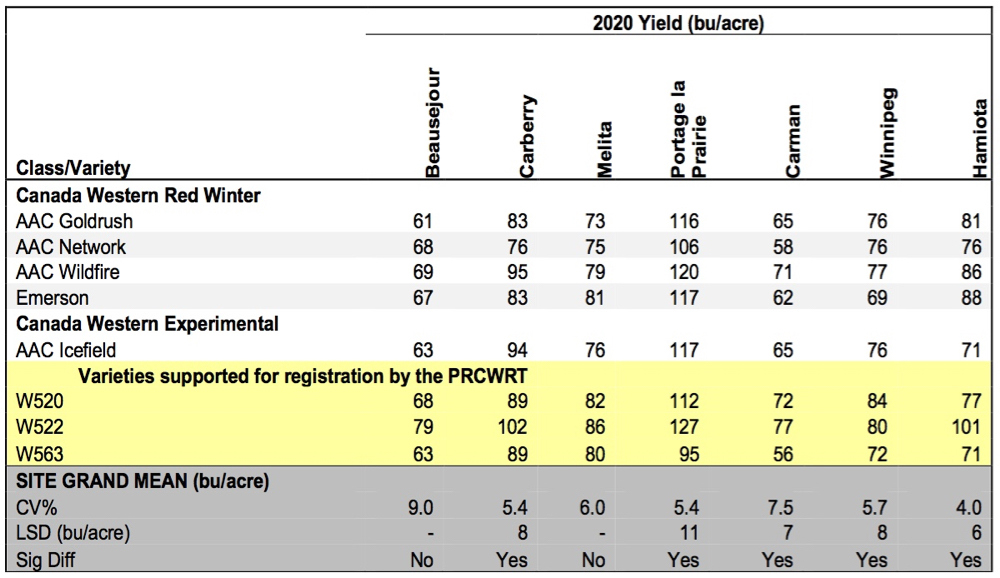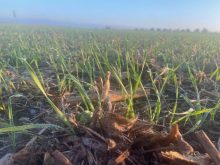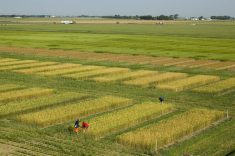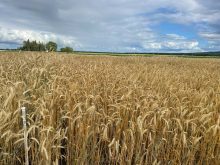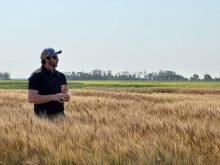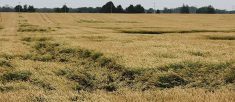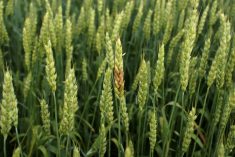Yield results are in from the 2020 MCVET (Manitoba Crop Variety Evaluation Team) fall rye and winter wheat testing locations. In addition to yield, agronomic and disease-resistance information for tested varieties is shown in the variety description tables.
Things to consider
Comparing yields: Data provided in the yield comparison tables helps to compare varieties at each site. Use the statistical information provided in the grey-shaded area located at the bottom of the table to see if differences are significant. To know if yield differences mean something, look at significant difference (Sig Diff) for each site, indicated as “yes” or “no.” If “yes,” then yield differences between varieties indicate real differences. When a site has shown significant difference, the least significant difference (LSD) value is also shown, indicating the number of bushels per acre (bu./acre) that varieties must differ by to be considered significantly different. For example, winter wheat varieties at the Carberry site must differ by more than eight bu./acre to be significantly different.
Read Also

Manitoba sclerotinia picture mixed for 2025
Variations in weather and crop development in this year’s Manitoba canola fields make blanket sclerotinia outlooks hard to pin down
Compare long-term yields: Yields at a single site in a single year can be a poor indicator of how the variety may perform in your field in 2021. Look at long-term yield data or yields collected over many years and locations to get a better indication of potential performance over a range of environmental conditions. When choosing a new variety, it is best to look at past Seed Manitoba guides, available at www.seedmb.ca, to see how consistently a variety performs across years and locations.
Agronomic and disease resistance: Yield is important, but other characteristics like maturity, height, standability, winter hardiness and disease resistance are critical to maximizing yield potential and quality. Diseases such as fusarium head blight can have a large impact on yield and quality. Choosing a variety with an increased resistance rating helps to reduce impact of fusarium infection in high-risk years.
For additional seed sourcing, see the online Pedigree Seed Locator. The seed locator displays seed produced in the current year that has been certified by the Canadian Seed Growers’ Association.
Seed Manitoba 2021 will be available November 26, 2020. The guide will provide the small plot, replicated and unbiased information on post-registration variety performance of many crop types in Manitoba gathered this year.
Seed Manitoba is a collaborative effort between the Manitoba Seed Growers’ Association, Manitoba Agriculture and Resource Development, and the Manitoba Co-operator.
Anne Kirk is Manitoba Agriculture and Resource Development’s cereal crop specialist. Contributors to the early release of this data include MCVET co-ordinator Chami Amarasinghe, University of Manitoba wheat breeder Anita Brûlé-Babel, Agriculture and Agri-Food Canada barley breeder Ana Badea, as well as MCVET site contractors and funding agencies.






